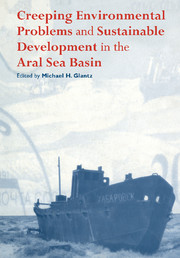Book contents
- Frontmatter
- Contents
- List of contributors
- Introduction
- 1 Sustainable development and creeping environmental problems in the Aral Sea region
- 2 Ecological disaster linked to landscape composition changes in the Aral Sea basin
- 3 Alteration of water level and salinity of the Aral Sea
- 4 Desertification in the Aral Sea region
- 5 Climate fluctuations and change in the Aral Sea basin within the last 50 years
- 6 Priaralye ecosystems and creeping environmental changes in the Aral Sea
- 7 Public health in the Aral Sea coastal region and the dynamics of changes in the ecological situation
- 8 The impact of political ideology on creeping environmental changes in the Aral Sea basin
- 9 Change of the rivers' flow in the Aral Sea basin (in connection with the problem of quantitative assessment and consideration of environmental after-effects)
- 10 Fish population as an ecosystem component and economic object in the Aral Sea basin
- 11 Creeping environmental changes in the Karakum Canal's zone of impact
- 12 Environmental changes in the Uzbek part of the Aral Sea basin
- 13 Creeping changes in biological communities in the Aral Sea
- Index
13 - Creeping changes in biological communities in the Aral Sea
Published online by Cambridge University Press: 19 October 2009
- Frontmatter
- Contents
- List of contributors
- Introduction
- 1 Sustainable development and creeping environmental problems in the Aral Sea region
- 2 Ecological disaster linked to landscape composition changes in the Aral Sea basin
- 3 Alteration of water level and salinity of the Aral Sea
- 4 Desertification in the Aral Sea region
- 5 Climate fluctuations and change in the Aral Sea basin within the last 50 years
- 6 Priaralye ecosystems and creeping environmental changes in the Aral Sea
- 7 Public health in the Aral Sea coastal region and the dynamics of changes in the ecological situation
- 8 The impact of political ideology on creeping environmental changes in the Aral Sea basin
- 9 Change of the rivers' flow in the Aral Sea basin (in connection with the problem of quantitative assessment and consideration of environmental after-effects)
- 10 Fish population as an ecosystem component and economic object in the Aral Sea basin
- 11 Creeping environmental changes in the Karakum Canal's zone of impact
- 12 Environmental changes in the Uzbek part of the Aral Sea basin
- 13 Creeping changes in biological communities in the Aral Sea
- Index
Summary
In recent years the environmental crisis of the Aral Sea basin has attracted worldwide interest. International, governmental, and public organizations, as well as different agencies of the United Nations and the World Bank have tried to comprehend the reasons for the initiation of this crisis and to overcome its adverse effects. The adverse effects of the crisis on socio-economic processes in the region and on the health of the local population have been reviewed in the scientific literature (e.g.,Micklin, 1991; Glantz et al., 1993; Elpiner, this volume) and in popular science publications (Ellis, 1990). Meanwhile, when purely biological problems are considered in such publications, they have either been considered only superficially or have not been considered at all. The notion of creeping environmental changes per se in the Aral Sea proper has been considered only slightly in the scientific literature. This is even more true for aquatic communities because the studies of such communities are more labor-intensive compared with studies of terrestrial ecosystems.
This paper attempts to fill the gap in this area, based on field observations over the past 16 years.
In spite of insufficient detailed information on many of the ecosystems of the Aral Sea, it is possible to state with a great degree of certainty that creeping environmental changes began to appear in the mid-twentieth century. These changes were not initially connected with human-induced desiccation of the Aral Sea but were caused by large-scale acclimatization processes. For example, beginning in 1927, 18 fish species were introduced into the Aral Sea, of which 15 survived and inhabited the sea for some period of time (Karpevich, 1975).
- Type
- Chapter
- Information
- Publisher: Cambridge University PressPrint publication year: 1999
- 1
- Cited by



